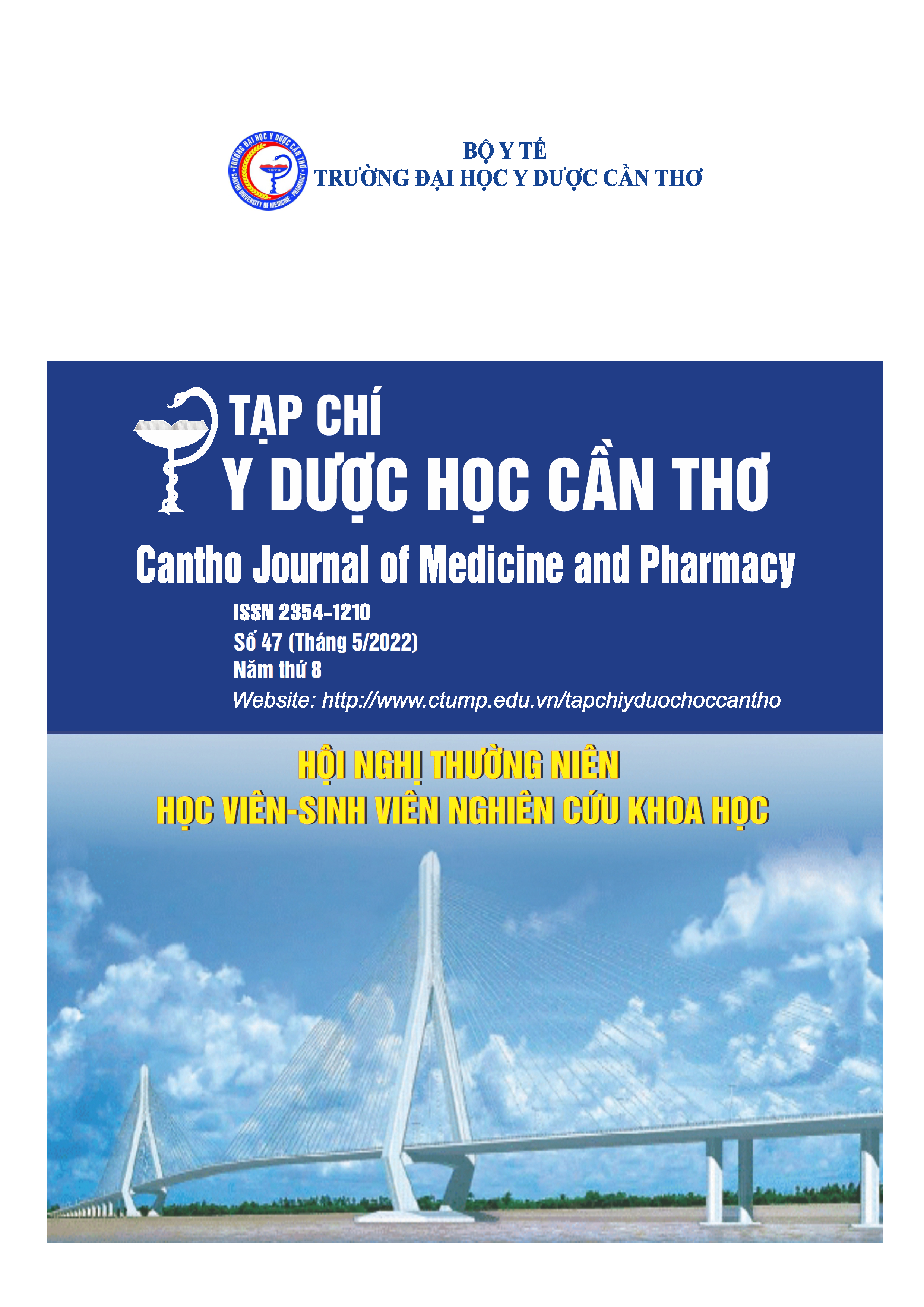Effectiveness of low-level Diode laser therapy in recurrent aphthous stomatitis treatment at Can Tho University of Medicine And Pharmacy Hospital in 2020-2022
Main Article Content
Abstract
Background: Recurrent aphthous stomatitis (RAS) are the most common oral ulceration in lesions of the oral mucosa. Treatment aims to reduce pain and healing time. Low-level Diode laser therapy can relieve pain, anti-inflammatory, reduce edema, stimulate cell biology, and stimulate healing. Low-level Diode laser therapy is an alternative therapy to conventional drug use, promising to help improve the quality of life, improve the patient's quality of life and avoid complications caused by long-term drug use. Objectives: To evaluate the therapeutic effect of a low-level Diode laser on RAS treatment to reduce pain, size of ulcers, and healing time. Materials and methods: A clinical study was conducted on 30 patients who presented RAS lesions were treated with low-level laser therapy. The patients were evaluated for the size, position, pain score, form of ulcers, healing time before and immediately, fourth and sixth day after treatment. The data was analyzed using SPSS 20. Results: The VAS score pre-treatment was 4.33±1.65, immediately post-treatment was 1.20±1.06. The size of ulcers pre-treatment was 4.58±2.35mm, and post-treatment fourth day was 2.47±2.30mm. The healing time was 5.04±0.32 days. Conclusion: Low-level Diode laser therapy is effective in RAS treatment to reduce pain, size of ulcers, and healing time.
Article Details
Keywords
Recurrent aphthous stomatitis, low-level Diode laser therapy, VAS score
References
2. Albrektson, L. Hedström, H. Bergh (2014), “Recurrent aphthousstomatitis and pain management with low-level laser therapy: a randomized controlled trial”, Oral Surgery, Oral Medicine, Oral Pathology and Oral Radiology, vol 117, no 5, pp.590-594.
3. Bensadoun RJ, Franquin JC, Ciais G, Darcourt V, Schubert MM, Viot M (1999), “Low-energy He/Ne laser in the prevention of radiation-induced mucositis: A multicenter phase III randomized study in patients with head and neck cancer”, Support Care Cancer, vol 7, pp.244-252.
4. De Souza T. O. F, Martins M. A. T, Bussadori S. K, Fernandes K. P. S, Tanji E. Y, Mesquita- Ferrari R. A, & Martins M. D (2010) “Clinical evaluation of low-level laser treatment for recurring aphthous stomatitis”, Photomedicine and Laser Surgery, 28(S2), S-85.
5. Eisen D, Carrozzo M, Bagan Sebastian J-V, and Thongprasom K (2005), “Number V. Oral lichen planus: clinical features and management”, Oral Diseases, vol. 11, no. 6, pp.338-349.
6. Elisabetta, Rocca Jean-Paul (2019), “Photobiomodulation Therapy in Oral Medicine: A Guide for the Practitioner with Focus on New Possible Protocols”, Photobiomodulation, Photomedicine, and Laser Surgery, Volume XX, Number XX, pp.1-12.
7. Fernandes R, Tuckey T, Lam P, Sharifi S, Nia D (2008), “The best treatment for aphthous ulcers- An evidence based study of literature”, J Am Dent Ass, vol 134, pp.200-207.
8. Han M, Fang H, Li QL, Cao Y, Xia R, Zhang ZH (2016), “Effectiveness of laser therapy in the management of recurrent aphthous stomatitis: a systematic review”, Scientifica (Cairo) 2016, ID 9062430.
9. Khademi H, Shirani Am, Nikegbal F (2009), “Evaluation of low level laser therapy in recurrent aphthous stomatitis”, Shiraz Univ Dent J, vol 10, issue 2, pp.160-162.
10. Laakso EL, Richardson CR, Cramond T (1993), “Factors affecting low level laser therapy”, Aust J Physio, vol 39, pp.95-99.
11. Manaf Taher Aga (2007), “Low level laser therapy as a solution in dental clinic - A review and case report”, J Oral Laser Appl, vol 7, pp.65-73.
12. Natah, S. S., Konttinen, Y. T., Enattah, N. S., Ashammakhi, N., Sharkey, K. A., & Häyrinen- Immonen, R. (2004), “Recurrent aphthous ulcers today: a review of the growing knowledge”, International journal of oral and maxillofacial surgery, 33(3), pp.221-234.
13. Shimizu N, Yamaguchi M, Goesk T, Shibata Y, Takiguchi H, Iwa- sawa T, et al. (1995), “Inhibition of prostaglandin E2 and interleukin 1- beta production by low-power laser irradiation in stretched human periodontal ligament cells”, J Dent Res, vol 74, pp.1382-88.
14. Smith KC (2005), “Laser (and LED) therapy is phototherapy”, Photomed Laser Surg, 23, pp.78-80.
15. Yarak S, Okamoto OK (2010), “Biostimulation effects of low power laser in the repair process”, An Bras Dermatol, vol 85, issue 6, pp.849-55.


